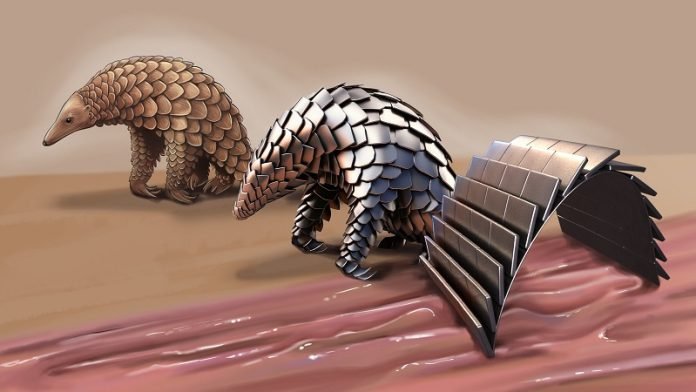
Have you ever seen a pangolin?
These adorable critters look like walking pine cones, and they’re the only mammals totally covered in hard, protective scales made of keratin, the same stuff our hair and nails are made from.
These scales overlap and are attached to a soft skin layer underneath, which helps them curl up into a ball if they sense danger.
Scientists from the Physical Intelligence Department at the Max Planck Institute for Intelligent Systems in Stuttgart, Germany were very interested in this ability of the pangolin.
They created a small, flexible robot inspired by it. The robot, just like the pangolin, can curl up into a ball in a flash, and it can also generate heat when necessary.
This new robot was revealed in a research paper published in Nature Communications.
The robot is tiny, only about two centimeters long, and made of two layers.
The soft layer is a polymer filled with tiny magnetic particles, and the hard layer is composed of metal parts arranged in layers that overlap like the pangolin’s scales. Despite being partly made from metal, the robot is still soft and flexible enough to be used safely inside the human body.
This robot responds to magnetic fields. When exposed to a low-frequency magnetic field, the scientists can control the robot to curl up into a ball and move it wherever they want. The robot’s metal parts stick out like scales, but they don’t hurt any surrounding tissue.
When in its ball form, the robot could potentially transport particles, such as medicines. Imagine a day when this tiny machine could travel through our digestive system to deliver medication!
Moreover, when this robot is exposed to a high-frequency magnetic field, it can heat up to over 70° C due to the embedded metal. This is particularly useful, as heat can be used in various medical procedures like treating blood clots, stopping bleeding, and removing tumor tissue.
It’s not common to find free-moving robots like this that can both navigate complex environments and generate heat.
This pangolin-inspired robot is therefore seen as an exciting innovation for modern medicine. It’s hoped that one day it will be able to reach even the narrowest and most sensitive parts of the body in a minimally invasive way and generate heat as required.
The researchers have already shown in a video how they can maneuver the robot through animal tissue and artificial organs. So, watch this space, as the future of medicine might involve a tiny robot that takes cues from nature!



